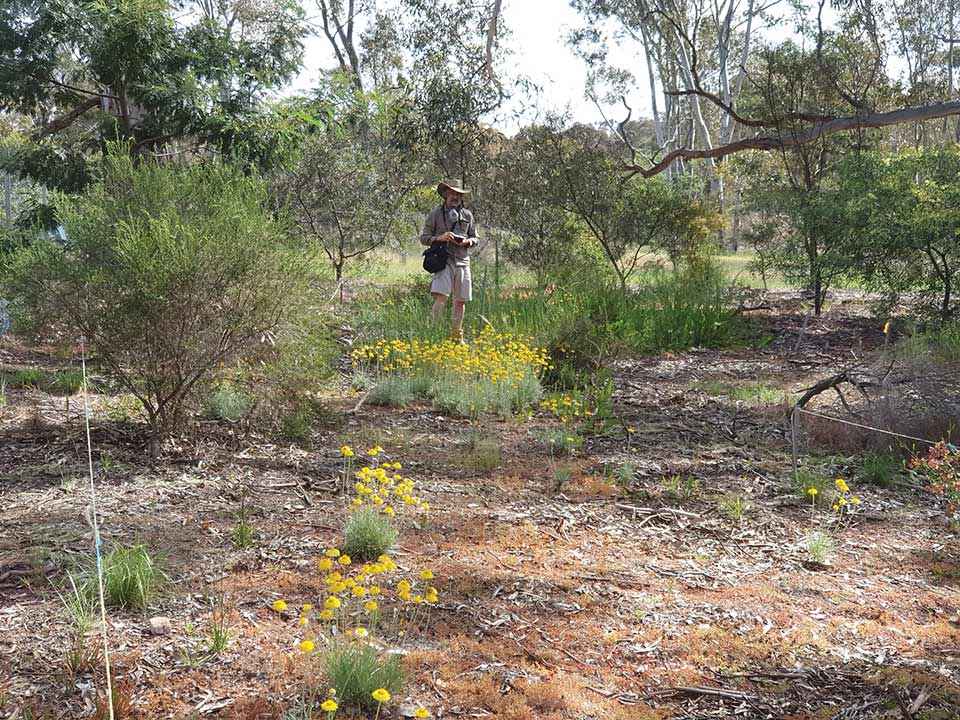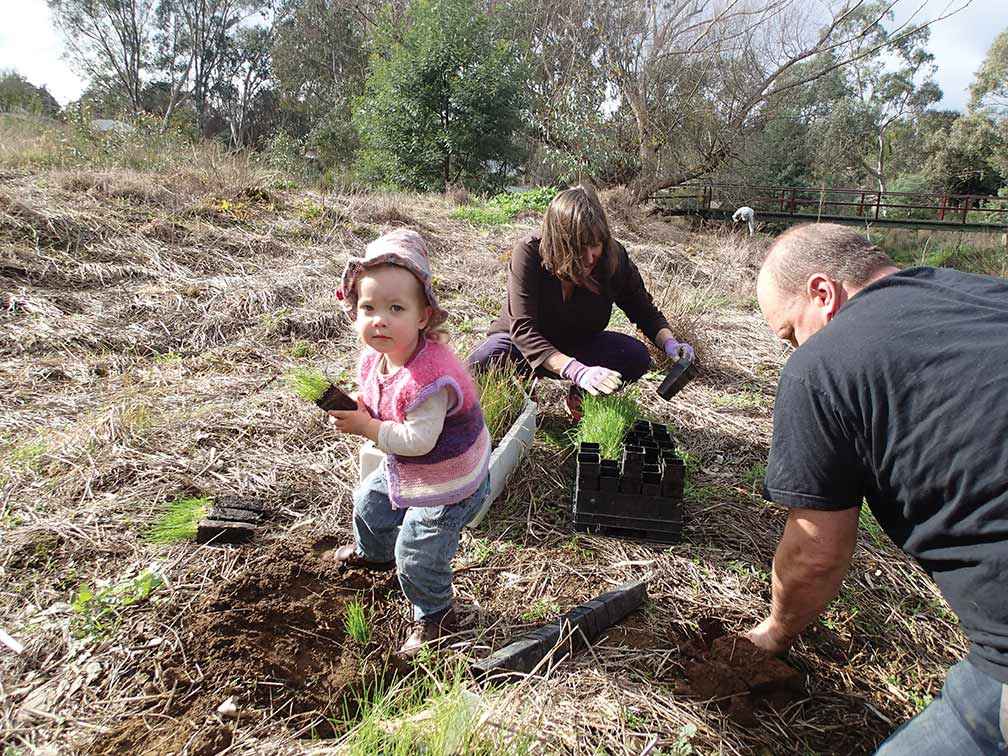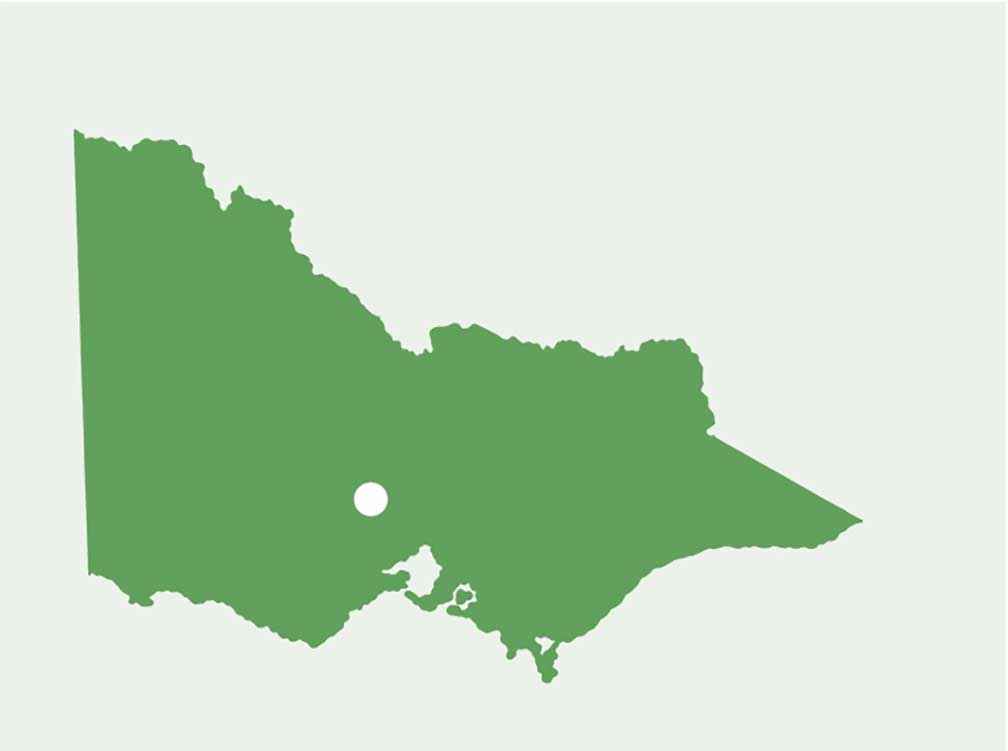Victorian Landcare Magazine - Summer 2022 , Issue 83

The Friends of Campbells Creek Landcare Group (FCC) are active in an area of Central Victoria devastated by gold mining and subsequent weed invasion. Since it started in 2000, the group has transformed creek-side public land previously dominated by blackberry, gorse, and willows.
Nearly all the ground flora species were missing, with herbaceous weeds preventing most native plants from regenerating. The group is still learning which species of ground flora can be restored, what’s sustainable with limited maintenance effort and how restoration helps exclude weeds and promotes recruitment of natives.
Taking control of the soil surface vegetation is important – that’s where all our plants, except mistletoes, begin life. Without self-recruitment we would only be able to maintain a few large and long-lived species. It’s largely a trial-and-error process. We plant or direct sow species, but it can take years to discover their ability to persist or regenerate.
FCC members have now re-introduced over 100 missing plant species of which around 40 now exist as self-recruiting populations.
Although gold mining devastated Campbells Creek, we think what we’ve learnt is applicable elsewhere and will be of interest across Victoria.
Large native herbs cope with and even suppress competition from the weeds that proliferate in shallow parts of the creek and at its margins.
Australian gypsywort (Lycopus australis), was rare in our district, only being known from one or two places. It grows to 1.5 metres tall and one plant can form a dense stand several metres wide.

Above: Bolboschoenus medianus, Persicaria decipiens, Carex appressa, Cyperus gunnii and Alisma plantago-aquatica are visible in the semi-aquatic zone – along with some weeds.
The club-rushes Bolboschoenus medianus and Schoenoplectus tabernaemontani have established and recruited new populations. Another excellent herb is Persicaria decipiens. We’ve also re-introduced the locally rare species Persicaria subsessilis, which is now spreading successfully.
A defining feature of riparian zones is the abundance of resources for plant growth, but most of Campbells Creek’s original soil was destroyed. Only a few hardy species like river red gum managed to recolonise after the gold mining era. Since then, floods deposited new soil, but the native vegetation did not recover.
In the 1980s, there were only five individual wattle plants along the entire 10-kilometre length of Campbells Creek.
Our restoration work led to thousands of wattles and other woody species like tree violet recolonising the riparian zone, but the ground flora was still absent.
Large tussocks like Poa labillardierei, Carex appressa, C. tereticaulis and some other large sedge species have been the key to taking control of the ground layer in the riparian zone that is so vulnerable to weed invasion.

Above: Direct sown Poa labillardierei 20 months after sowing on a floodplain.
The seed of the Poa tussock grass is easy to collect. By sowing it we can quickly establish a dense stand that out-competes most weeds. So far, our direct sowing of sedges isn’t producing adequate densities, so we plant seedlings. This is expensive, but large sedges suppress weeds, and we can overspray them with selective herbicides against broad-leaf or grass weeds that re-invade.

Above: Friends of Campbells Creek members replanting tussocks in the riparian zone along the creek.
Preparing the site by eradicating invasive perennial weeds is critical. Although this can take up to four years, it greatly reduces follow up maintenance.
Reducing the weed cover is transformative—more native species recruit even after native ground flora species dominate. The challenge in over-fertile environments is ensuring gains are not lost. Perennial weeds will reinvade, but we’re finding that our volunteers can keep up with the maintenance, provided we are vigilant with monitoring.
Mount Alexander Shire made some council owned freehold land in the creek surrounds available and with council assistance, FCC has been exploring floristic restoration in a dryland environment well above the riparian zone. The entire property is a challenge as gold mining activity removed most of the topsoil. We’d previously reduced gorse and re-established some native woody species in our trial areas. Our first trial here in an open, sunny area with low soil fertility, relatively low weed cover and plenty of native grasses was a failure. We discovered that red-legged earth-mites were destroying our direct sown wildflowers while they were tiny seedlings.
We’d already learnt elsewhere that these species could be re-established by direct seeding, so in 2019, we tried again in a similar site nearby in which canopy trees provided partial shading. The Loddon Prison Landmate team fenced the site to exclude grazing animals.
We’ve now re-introduced more than 110 understorey and ground flora species by sowing or planting.
For most species it’s too early to tell whether they will go on to self-seed, but several are already proving successful.
Arthropodium minus, the smallest of our local chocolate lilies, has been the best coloniser from direct seeding. In our tough conditions (poor soil, competition from mature trees and unreliable spring rainfall) it can take three years from sowing to flowering. Leucochrysum albicans is a quick growing everlasting daisy that is easily established from seed. Linum marginale is another quick growing species that soon flowers and sets seed. Lagenophora gunniana is a small perennial daisy that readily self-seeds and Wahlenbergia multicaulis is a very hardy perennial bluebell.
Although we couldn’t source seed of Chrysocephalum semipapposum or C. apiculatum, both these everlasting daisies that we planted are now recruiting new individuals, with some seedlings even appearing outside the fence.
• Remove perennial weeds before attempting restoration. Many of our native ground flora can coexist with, or even out-compete, annual weeds, but eradicating perennial weeds among native herbs is difficult.
• Be patient. Preparing a restoration site can take several years. Some native plants take years to mature.
• Soil nutrient levels are a key consideration. The combination of soil disturbance and excessive nutrient levels is fatal in fragmented native vegetation.
• Seed production areas are essential for producing enough seed of ground flora species. FCC produces seed of some of these species in private gardens. We can now also collect seed from our previous restoration successes.
• Restoration in severely damaged, weedy environments is not practicable without herbicides. Selective herbicides (for either broad-leaf or grass weeds) are also useful in follow up weed control work in newly established stands of ground flora.
In the woodlands and forests of our district, ground flora species comprise the bulk of our plant biodiversity, but all too often they were eradicated by past land management practices. This is especially so in riparian zones and more fertile areas. We’re learning that with minimal maintenance, it is possible to sustain assemblages of at least some indigenous species and that these support natural regeneration and help exclude weeds.
Ian Higgins has worked in revegetation and environmental planning in Victoria for more than 30 years and was one of the instigators of the Friends of Campbells Creek.
For more information go to www.focc.org.au or email ianhiggins54@gmail.com

Above: Location map - Campbells Creek